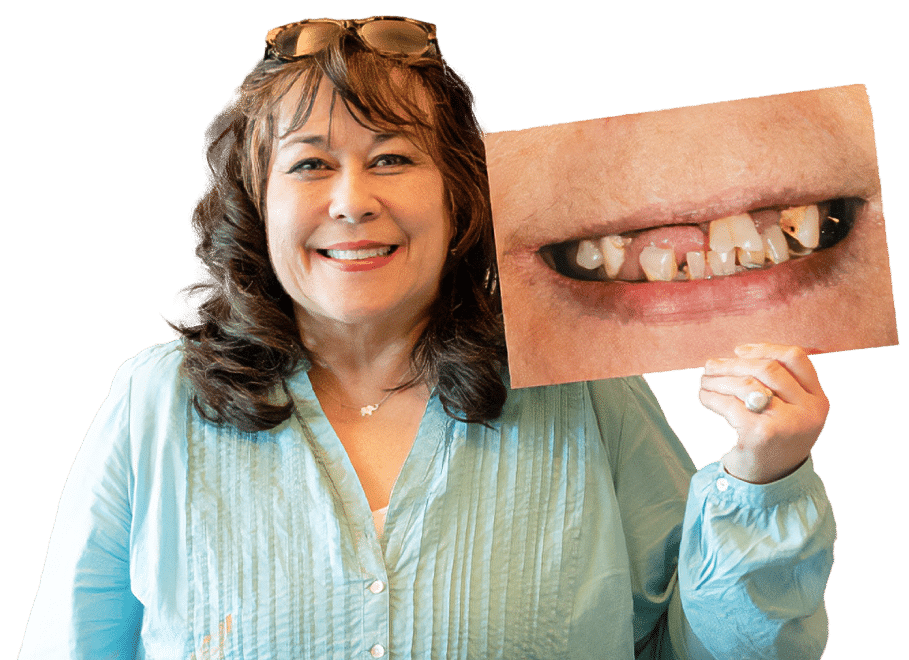Brown spots on teeth can be embarrassing. It is not unusual to have discolorations on our teeth, since stains from foods and debris is common, but those usually brush off. Sometimes the surface of teeth get affected from things like etching for orthodontic brackets (braces), trauma to teeth, and so on. When stains become “intrinsic” or “inside the tooth”, then normal cleaning isn’t enough.
As with all things and options, the most common goal in dentistry is to “do the least amount necessary to achieve a goal.” In other words, “The best dentistry is NO dentistry.”
There are many reasons for brown spots or other discolorations and often it is “not our fault”. Sometimes “things happen”. In certain areas of the world, water is not as “safe” or “pure” as we have here in the USA, and even treated water varies from city to city and state to state. The mineral content in water will affect the colors of the teeth as they develop, and may affect a person’s self esteem. While debate rages on here in the states about the safety of fluoride, there is no denying that it has an effect on out teeth. Stronger teeth may also be ugly teeth!
A first option is to chemically alter the enamel of teeth to change the color (teeth whitening or bleaching). An abrasive acid-slurry is used to polish the teeth to begin followed by a paste placed into a tray and worn for a period of time (days/weeks). If the stains are shallow enough this may be all that is needed to get the desired effect. The fee for this is usually time dependent, as there aren’t a lot of materials involved, but it is VERY time intensive, as it often requires some home effort. Treatment like this often leads to a blending effect, meaning the spots are not entirely GONE, but the contrast is minimal and an improvement over where we started from. The brown spots become more white, but are not gone entirely.
A form of filling, with no drilling, comes from DMG. ICON. The acids create porosity that gets filled with a resin, or filling material. This resin is tooth colored and also thin enough to “blend” in. This will cost a bit more than the chemical option and will cost about the same as a filling. Icon is NOT a replacement to a filling, if enamel is decayed and broken down (cavitated) then the “bad stuff” must be removed. This gap in the surface of the tooth (not quite a crater) must be replaced with a filling, veneer, or crown. When indicated, Icon can be a fantastic option.
A bit more definitive is simply placing a filling. Perhaps the fastest option, this is a routine procedure in nearly every dental office. Since stains are usually very shallow, anesthesia (numbing) may not be necessary; however, numbing is always available and an option! This process is simply done by taking an instrument that rotates at a high rate and sprays water. After a few passes over the offending tooth structure, what remains is clean and healthy enamel. A tooth colored resin material is then bonded in to fill the space and the polished smooth. This restoration CAN last for many years if kept clean, but still requires monitoring by a dentist to be sure decay does not set in.
Some people (including dentists) will erroneously call this process “bonding”. This isn’t a very accurate term, as “bonding” is simply a verb and is the action to adhere a filling or a porcelain veneer to a tooth. Since this word is used for many things, it can lead to some confusion.
Often, the best solution is the most involved option. Porcelain veneers, when done in the RIGHT office with a dentist that has been adequately trained, can be VERY conservative and last a VERY long time. Often, NO removal of tooth structure is needed, but in many cases a minor amount of shaping and contouring is best. Porcelain veneers will allow you to control the size, shape, and color of your teeth, and this process is the best choice if “perfection” is your goal. I would caution against striving for perfection, as “perfect” if often nearly impossible.
More To Explore
If you have dentures to replace your missing teeth, then you’re probably already aware of the many benefits that come...
If your dentist recommends root canal therapy to prevent extraction, don’t worry about a large bill. It’s more affordable to...
Is your jaw stiff or painful to move on one or both sides? A disorder of the temporomandibular joints (TMJ)...
Every Patient Deserves A Healthy, Beautiful Smile.
We take the time to make everything right. Just imagine:
- Get your life back with renewed confidence
- Be healthy and feel amazing for a lifetime
- Eat and love your favorite foods again

- I Need a Checkup & Cleaning
- I am Concerned About Bleeding Gums
- I Have a Cavity or Broken Tooth
- I am Missing One or More Teeth
- The Whole Tooth Podcast
- I Have Pain When Opening or Closing my Mouth
- I am Unhappy with My Smile
- I Want a Straighter Smile
- I am Scared of the Dentist
- I am In Pain & Need Help
- I Need My Wisdom Teeth Removed
- I am Interested in Sleep Apnea Treatment
Designed by Dental Implant Machine
Discover your orthodontic options to see which is the best for you
Unlock a Restful Night’s Sleep
Discover the Best Option to Get a Beautiful White Smile
Discover the Best Option to Get a Beautiful White Smile


